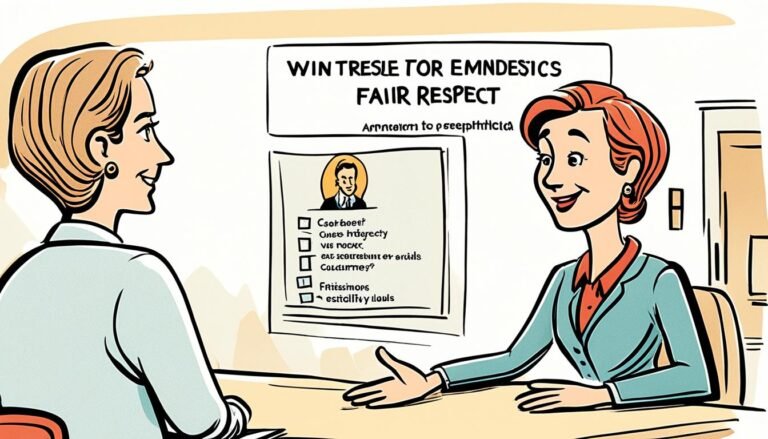Win with Effective Follow-Up Strategies in Sales
Effective follow-up strategies are essential in sales to turn prospective customers into actual buyers. Many salespeople make the mistake of not following up enough or giving up too quickly. According to a study, 80% of sales require an average of five follow-ups to close, but 44% of sales reps only follow up once before giving up. It is crucial to understand the importance of follow-up and how it can significantly impact sales success.
Key Takeaways:
- Follow-up is crucial in sales to increase the chances of closing deals.
- Many salespeople give up too quickly and miss out on potential sales.
- Average of five follow-ups are needed to close a sale, but most sales reps only follow up once.
- Effective follow-up can significantly impact sales success.
- Understanding the importance of follow-up is essential in improving sales performance.
What is a Sales Follow-Up?
A sales follow-up is a crucial step in the sales process that occurs after the initial pitch to a prospective customer. It involves reaching out to the prospect through various methods, such as phone calls, emails, or even face-to-face meetings. The purpose of a sales follow-up is to nurture the relationship with the prospect, address any concerns or questions they may have, and ultimately guide them towards making a purchase decision.
Following up with potential customers is of utmost importance as it significantly increases the chances of closing deals and converting leads into loyal customers. Without proper follow-up, many sales opportunities can be lost, and potential sales left on the table.
“Most people think ‘selling’ is the same as ‘talking.’ But the most effective salespeople know that listening is the most important part of their job.” – Roy Bartell
By engaging in follow-up activities, salespeople can continue the conversation with prospects, understand their needs and preferences, and provide the necessary information and support to address any barriers to purchase. This ongoing communication helps in building trust, showcasing expertise, and demonstrating a genuine interest in the prospect’s success.
The sales follow-up process can vary in duration and intensity, depending on the complexity of the product or service being offered and the prospect’s buying journey. It is essential to tailor the follow-up approach to each individual prospect, taking into consideration their communication preferences and preferred timeline for decision-making.
In order to effectively execute sales follow-up strategies, salespeople need to leverage various communication channels, such as phone calls, emails, social media platforms, and even in-person meetings. The choice of the appropriate channel depends on the prospect’s preferences and the nature of the product or service being offered.
Importance of Sales Follow-Up
The importance of sales follow-up cannot be overstated. Here are some key reasons why follow-up is essential:
- Builds relationships: Follow-up activities enable salespeople to build meaningful relationships with prospects, establishing trust and rapport over time.
- Addresses concerns and questions: Follow-up provides an opportunity to address any concerns or questions that the prospect may have, clearing up any doubts and facilitating the decision-making process.
- Increases closing ratio: Regular and timely follow-up significantly increases the chances of converting leads into customers, increasing the overall closing ratio.
- Ensures no missed opportunities: Without follow-up, potential sales can easily slip through the cracks and be missed.
Ultimately, a well-executed sales follow-up process helps salespeople stay top of mind with prospects, foster strong relationships, and ultimately close more deals.
Sales Follow-Up Techniques
Implementing effective follow-up techniques is essential for sales success. By utilizing a variety of methods and providing value at each stage of the follow-up process, salespeople can increase their chances of closing deals and converting prospects into loyal customers.
Use Varied Follow-Up Channels
Reaching out to prospects through different channels is a great way to cater to their preferences and improve response rates. Phone calls, emails, and social media platforms like LinkedIn can all be effective follow-up channels. By diversifying the channels used, salespeople can engage prospects on platforms where they are most active, increasing the likelihood of a meaningful interaction.
Space Out Follow-Ups Appropriately
Timing is crucial when it comes to follow-ups. It’s important to space out follow-ups appropriately based on the prospect’s timeline and needs. Bombarding prospects with frequent follow-ups can be counterproductive and can hinder the relationship-building process. A well-timed follow-up shows consideration and allows the prospect to progress in their decision-making journey.
Provide Value with Each Follow-Up
Each follow-up should offer something of value to the prospect. This can be in the form of personalized content, such as industry insights or relevant resources that address their specific pain points. By providing value, salespeople position themselves as trusted advisors and demonstrate their expertise, which can significantly impact the prospect’s perception of the salesperson and the product/service being offered.
| Follow-Up Technique | Description | Benefits |
|---|---|---|
| Phone Calls | Directly reaching out to prospects through phone conversations. | – Allows for immediate feedback and clarification. – Allows for a personal connection between the salesperson and prospect. |
| Emails | Sending follow-up emails with personalized content and information. | – Can be easily tailored to the recipient’s needs and preferences. – Provides a written record for future reference. – Allows for attachments and links to additional resources. |
| Social Media | Engaging with prospects through social media platforms like LinkedIn. | – Showcases the salesperson’s professionalism and industry knowledge. – Allows for building relationships in a casual and interactive way. – Provides an opportunity to showcase testimonials and success stories. |
By adopting these sales follow-up techniques, salespeople can improve their overall sales effectiveness and increase their chances of closing more deals. These techniques allow for personalized communication while providing value to prospects, ultimately building stronger relationships and driving sales success.
Importance of Subject Lines
Subject lines are a critical component of email follow-ups as they can make or break whether the recipient opens the email. Generic subject lines like “Just checking in” or “Follow up” often get ignored or end up in the recipient’s trash folder. To increase open rates, it’s crucial to personalize subject lines by including the recipient’s name. Short, to-the-point subject lines with a conversational tone tend to perform better.
Creating a sense of urgency or asking a direct question in the subject line can grab the recipient’s attention and motivate them to open the email. A well-crafted subject line not only entices the recipient to open the email but also sets the tone for the message within.
Here are some key tips for crafting effective subject lines:
- Personalize: Include the recipient’s name or other relevant details to make the email feel more individualized.
- Keep it concise: Subject lines should be short and to the point, typically no longer than 50 characters.
- Create urgency: Use words that convey a sense of urgency, such as “limited time offer” or “ending soon.”
- Pose a question: Asking a question in the subject line can pique the recipient’s curiosity and encourage them to open the email.
- Use catchy phrases: Employ attention-grabbing phrases or clever wordplay to make the subject line stand out.
Remember, the goal is to make the recipient curious enough to open the email and engage with your message. A well-crafted subject line sets the stage for a successful follow-up interaction.
Benefits of Keeping Follow-Ups Brief
When it comes to follow-ups in sales, less is often more. Keeping follow-ups brief can have significant benefits in terms of capturing the prospect’s attention and increasing the likelihood of a response. In today’s fast-paced business environment, prospects are busy and don’t have time for lengthy emails or phone calls. By keeping follow-ups concise, salespeople can make a strong impact in a short amount of time.
Short follow-up emails:
Email follow-ups should be kept to a maximum of six lines. In these few lines, salespeople must deliver a clear and compelling message that grabs the prospect’s attention. By being succinct, salespeople demonstrate respect for the prospect’s time and increase the chances of the email being read and responded to. It is crucial to focus on the key points and offer value in every communication.
Effective follow-up calls:
Phone calls should generally last no longer than ten minutes. During these calls, salespeople need to be direct and to-the-point. They should quickly address the purpose of the call and present any relevant information or offers. By respecting the prospect’s time and keeping the conversation concise, salespeople create a sense of urgency and convey professionalism.
To illustrate the benefits of keeping follow-ups brief, let’s consider an example. John, a salesperson at XYZ Company, sends a long and detailed follow-up email to a prospect who is already overwhelmed with their inbox. The email is likely to get lost in the clutter or ignored altogether. On the other hand, Mary, a salesperson at ABC Sales, sends a short and personalized follow-up email that quickly highlights the unique value proposition. This concise email captures the prospect’s attention and generates a response.
By keeping follow-ups brief, salespeople can:
- Maximize their chances of capturing the prospect’s attention
- Demonstrate respect for the prospect’s time
- Convey professionalism and efficiency
- Increase the likelihood of a response
- Focus on the key message and offer value in every interaction
In conclusion, brevity is key when it comes to follow-ups in sales. By keeping follow-ups concise and to the point, salespeople can make a strong impact in a short amount of time. This approach enables them to grab the prospect’s attention, increase response rates, and ultimately, drive sales success.
Knowing When to Stop
While following up persistently is crucial in sales, it’s equally important to know when to stop. Continuously pursuing a prospect beyond a certain point can become counterproductive and potentially annoying. By setting limits in follow-ups, salespeople can ensure they stop following up appropriately, maintaining professionalism and respecting the prospect’s boundaries.
On average, sending five to six follow-ups is reasonable. This gives ample opportunity for the prospect to respond and engage in further discussions. If there is no response after this point, it’s a clear indication that it’s time to stop contacting the prospect and redirect efforts towards other potential leads.
Before ending the follow-up process, it is recommended to send a final email, often referred to as a “break-up email.” This email allows the prospect a final chance to respond and express any remaining interest. The break-up email should be concise, polite, and respectful, thanking the prospect for their time and expressing understanding if they don’t wish to proceed at the moment.
Setting Limits in Follow-Ups
When determining the number of follow-ups, it’s essential to consider factors such as the prospect’s preferences, industry norms, and the complexity of the sales process. Each salesperson may have their own unique follow-up strategy, but the key is to strike a balance between persistence and respect.
- Set a limit of five to six follow-ups as a general guideline.
- Consider the prospect’s communication preferences. Some may prefer phone calls over email or vice versa.
- Be mindful of the specific industry’s follow-up standards. Different industries may have different response times and expectations.
Remember that not all prospects are ready to make a decision immediately, and it’s essential to respect their timeline. By setting limits in follow-ups, salespeople can efficiently allocate their time and energy, focusing on leads with higher potential for conversion.
Knowing when to stop follow-ups is crucial in maintaining a professional and respectful relationship with prospects. It also allows salespeople to optimize their follow-up efforts and concentrate on new opportunities. By implementing appropriate limits, salespeople can strike a balance between persistence and respecting prospects’ boundaries.

The Power of Thank You Notes
Sending a thank you note after making a sale is a powerful way to show appreciation to the customer and make the experience positive. It is an opportunity to thank the client for their trust and support and to provide contact details for any further assistance. Thank you notes can be sent via email or included with the invoice and should be personalized to make the client feel valued. This simple gesture can go a long way in building customer loyalty and fostering repeat business.
Expressing gratitude in sales is important for maintaining strong relationships with customers. By taking the time to send thank you notes, salespeople can show their appreciation for the customer’s business and reinforce the positive experience they had. It is a thoughtful way to acknowledge the customer’s trust and support, making them feel valued and appreciated.
Benefits of sending thank you notes include:
- Building customer loyalty: Thank you notes make customers feel valued and appreciated, encouraging them to continue doing business with you and refer others.
- Strengthening customer relationships: By expressing gratitude, salespeople can deepen their connections with customers and foster long-term loyalty.
- Creating a positive impression: Thank you notes leave a lasting impression on customers, demonstrating that the salesperson goes the extra mile to provide exceptional service.
- Increasing customer satisfaction: Thank you notes show that the salesperson genuinely cares about the customer’s experience and satisfaction, leading to higher levels of customer happiness and retention.
- Differentiating from competitors: Personalized thank you notes set salespeople apart from their competitors and make customers more likely to choose their products or services again.
By incorporating thank you notes into their follow-up strategies, salespeople can not only express appreciation but also nurture customer relationships, enhance satisfaction, and ultimately drive business growth.
Checking in with Clients
After completing a sale, it is crucial to check in with clients to ensure their satisfaction and maintain a positive relationship. This post-sale customer follow-up allows salespeople to gather valuable feedback, address any concerns, and reinforce their commitment to customer success.
One effective way to check in with clients is through personalized phone calls or emails. By reaching out, salespeople can ask about the customer’s experience with their purchase and show genuine interest in their satisfaction. This communication also provides an opportunity to address any concerns or issues the customer may have and offer assistance if needed.
During the check-in, it is essential for salespeople to actively listen to the customer’s needs and opinions. By understanding their perspective, salespeople can not only resolve any concerns but also gain valuable insights into how to improve their products or services. It is crucial to recognize that addressing customer concerns promptly and effectively can enhance customer loyalty and satisfaction.
Staying connected with clients through regular follow-up demonstrates a commitment to their long-term success. By continuing to engage and assist clients, salespeople can build trust and foster lasting business relationships. This ongoing communication also provides an opportunity to share relevant updates, upgrades, or additional products that may benefit the customer.
By making the effort to check in with clients post-sale, salespeople show that they value their customers and are dedicated to their satisfaction. This personalized approach goes a long way in increasing customer retention, generating positive word-of-mouth, and ultimately driving business growth.
Quote:
“Building strong customer relationships doesn’t end with a sale. Regularly checking in with clients post-sale shows that you are invested in their success and satisfaction.”– Sarah Johnson, Sales Consultant
Keeping Communication Open
Building strong and lasting relationships with clients goes beyond the initial sale. Open communication is essential in fostering ongoing customer engagement and providing continuous value. By obtaining permission to communicate with clients, salespeople can stay connected and deepen the customer relationship.
One effective way to keep communication open is by providing helpful information, updates, and resources that align with the client’s needs and interests. This ongoing engagement showcases a commitment to delivering value and ensures that clients feel supported even after the purchase.
It is also an opportunity to share relevant content, industry insights, and exclusive offers. By sharing valuable information, salespeople demonstrate their expertise and position themselves as trusted advisors in the customer’s eyes.
Benefits of Open Communication
Open communication benefits both the salesperson and the client. For salespeople, it allows them to understand their client’s evolving needs, challenges, and preferences. This insight enables them to provide personalized solutions and adapt their approach accordingly.
By staying engaged with clients, salespeople can identify upsell or cross-sell opportunities, strengthening their position as valuable partners rather than one-time vendors.
For clients, open communication provides a direct line to the salesperson for support, guidance, and additional information. It creates a sense of trust and reassurance that their salesperson is readily available to address any concerns or questions that may arise.
Ultimately, open communication paves the way for improved customer relationship management. It establishes a foundation for long-term loyalty, repeat business, and positive word-of-mouth referrals.
Best Practices for Open Communication
Here are some best practices to ensure effective and ongoing communication with clients:
- Obtain permission to communicate with clients through email or other preferred channels.
- Segment clients based on their interests, needs, and preferences to deliver more targeted and relevant information.
- Regularly send personalized communications that provide value, such as relevant articles, case studies, or industry updates.
- Use technology and automation tools to streamline communication processes while maintaining a personalized touch.
- Encourage clients to provide feedback, suggestions, and testimonials to foster a sense of collaboration.
- Stay responsive and attentive to client inquiries, ensuring timely and thorough follow-up.
Conclusion
Effective follow-up strategies are the key to achieving success in sales. By implementing a range of follow-up techniques, personalizing communication, and consistently providing value, salespeople can build strong relationships with prospects and secure more deals. Follow-up not only helps in closing sales but also plays a critical role in customer retention and satisfaction, leading to potential referrals.
It is crucial to understand the significance of effective follow-up and its impact on the overall sales process. By incorporating follow-up strategies into their sales approach, salespeople can optimize their efforts and improve their chances of success. Whether it’s a phone call, email, or social media interaction, each follow-up provides an opportunity to engage with prospects, address their concerns, and reinforce the value of the product or service being offered.
Furthermore, keeping communication open and maintaining a positive relationship with customers beyond the initial sale is equally important. Regularly checking in with clients, addressing their feedback, and providing ongoing support and resources show a commitment to customer satisfaction. This level of attentiveness not only fosters long-term loyalty but also increases the likelihood of repeat business and positive word-of-mouth referrals.
Overall, effective follow-up strategies are a vital component of successful sales. By following up consistently, salespeople can enhance their customer relationships, increase their closing rates, and ensure sustainable growth. Prioritizing customer retention and satisfaction through effective follow-up techniques is a formula for long-term success in sales.







